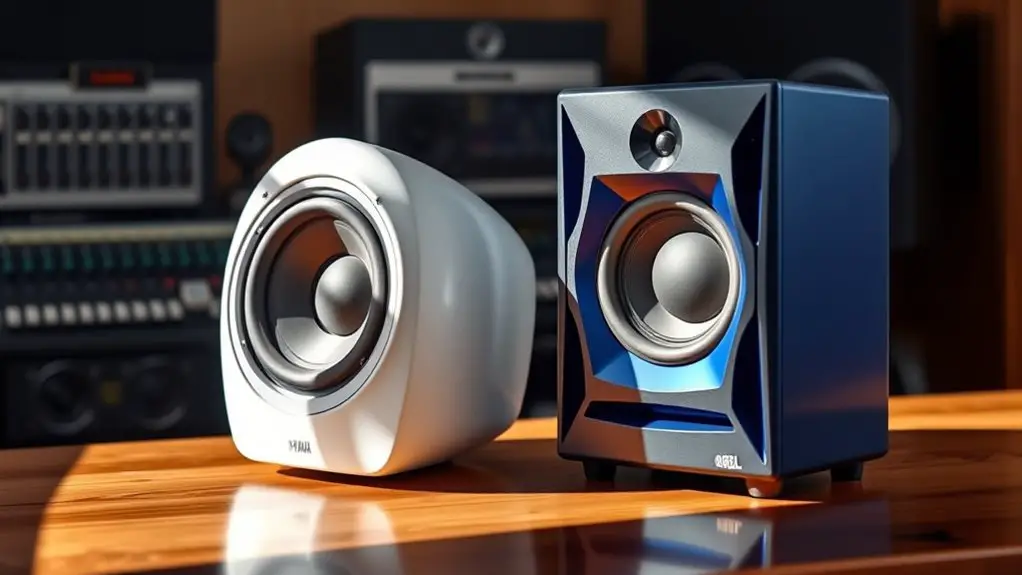When comparing the Yamaha HS5 and JBL 305P MKII, you'll notice key differences in design, sound, power, connectivity, and price. The HS5 boasts a minimalist design and excels in clarity with its 70-watt amplification. In contrast, the JBL 305P MKII offers pronounced bass and a higher 82-watt output for louder environments. Both monitors provide various connectivity options, but the HS5 is generally pricier. Understanding these distinctions can help you make an informed decision, so keep exploring the details.
Design and Build Quality
When it comes to design and build quality, both the Yamaha HS5 and JBL 305P MKII present compelling options for studio monitors. The Yamaha HS5 showcases a sleek, minimalist design aesthetic, featuring a white-coned woofer and a clean finish, which appeals to those valuing subtlety in their setup. In contrast, the JBL 305P MKII boasts a more modern look with its curved edges and attractive grille, making it eye-catching in any studio environment. Regarding material durability, both models are built with high-quality materials that guarantee longevity. The HS5's MDF cabinet minimizes resonance, while the JBL's robust enclosure enhances its overall sturdiness. Ultimately, you'll find that both monitors offer excellent design and durability, catering to varying visual preferences.
Sound Signature and Frequency Response
Both the Yamaha HS5 and JBL 305P MKII are designed to deliver accurate sound reproduction, but their sound signatures and frequency responses cater to different listening preferences. The HS5 is known for its remarkable sound clarity, making it ideal for critical listening and detailed mixing. Its frequency response tends to emphasize mid and high frequencies, providing a transparent sound profile. In contrast, the JBL 305P MKII offers a more pronounced bass response, appealing to those who enjoy a fuller low-end presence in their music. Its unique Image Control Waveguide enhances stereo imaging, allowing for a more immersive experience. Depending on your priorities—be it sound clarity or bass response—one monitor may suit your needs better than the other.
Power and Amplification
Power and amplification play essential roles in the overall performance of studio monitors, influencing their dynamic range and clarity at various volume levels. When comparing the Yamaha HS5 and JBL 305P MKII, you'll notice differences in amplifier efficiency and power handling. The HS5 features a built-in 70-watt amplifier, providing robust output while maintaining accuracy. In contrast, the JBL 305P MKII has a 82-watt amplifier, offering higher headroom and potentially greater power handling. This can affect how well each monitor performs at louder volumes without distortion. Your choice may depend on your specific needs and listening environment, as higher power handling can enhance the listening experience, especially in larger spaces. Ultimately, understanding these differences will help you make an informed decision.
Connectivity Options
The ability to connect studio monitors to various audio sources can greatly impact your workflow and versatility in a studio setup. The Yamaha HS5 offers balanced XLR and TRS input/output options, guaranteeing compatibility with professional audio equipment. In contrast, the JBL 305P MKII also features XLR and TRS inputs, but it includes a more extensive range of output options for greater flexibility. While neither monitor supports wireless connectivity, both models excel in wired connections, which can provide a more stable and reliable audio signal. Ultimately, your choice may depend on your specific input/output needs and how each monitor fits into your existing setup. Evaluate these connectivity options carefully to guarantee peak performance in your studio environment.
Price and Value for Money
When considering studio monitors, price and value for money are essential factors that can greatly influence your decision. Both the Yamaha HS5 and JBL 305P MKII offer unique benefits, but their price points can impact your affordability comparison. The HS5 tends to be slightly more expensive, while the 305P MKII provides a more budget-friendly option, appealing to those seeking a long-term investment without compromising quality.
| Monitor | Price Range |
|---|---|
| Yamaha HS5 | $199 – $249 |
| JBL 305P MKII | $149 – $199 |
Ultimately, evaluating your budget and intended use will help you determine which model provides the best value for your needs.
Frequently Asked Questions
Which Speaker Is Better for Small Studio Spaces?
In small studio spaces, you'll want speakers that provide sound isolation without overwhelming the room. Consider factors like clarity and size; both options can excel, but your choice depends on specific acoustic needs and preferences.
Can I Use These Speakers for Home Theater Systems?
You can use these speakers for a home theater, but speaker compatibility varies based on your system's requirements. They might excel in audio quality, yet consider the overall setup for ideal performance and experience.
What Is the Warranty Period for Each Speaker?
When considering warranty comparisons, the Yamaha HS5 typically offers a three-year warranty, while the JBL 305P MKII usually provides a two-year period. Both warranties reflect their commitment to speaker durability and performance reliability.
How Do the Speakers Perform in Untreated Rooms?
In untreated rooms, speaker placement greatly impacts sound quality. Poor room acoustics can lead to muddled bass and unclear highs. You'll need to experiment with positioning to achieve the best possible listening experience.
Are There Any Recommended Stands for These Studio Monitors?
You might wonder if the right stand can enhance your listening experience. For ideal monitor isolation, consider stands that allow adjustable height to align your speakers with your ears, improving clarity and overall sound quality.

